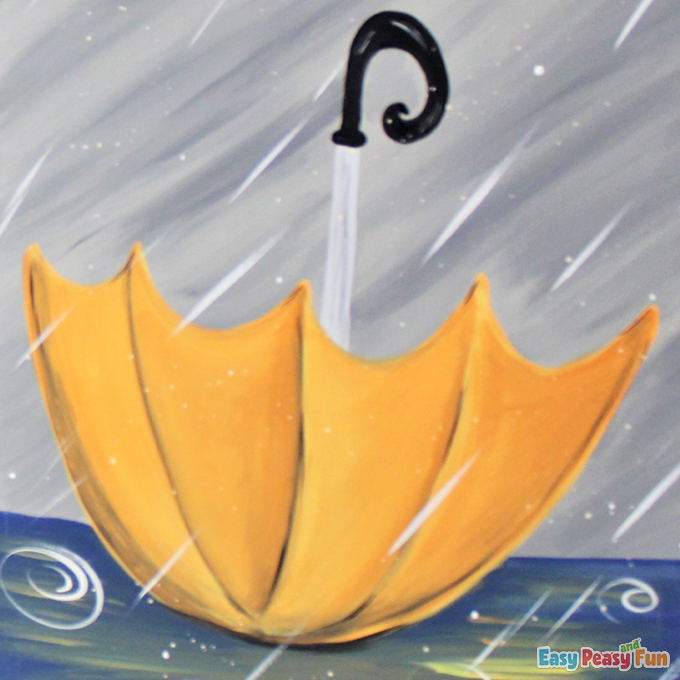If you love the idea of doing canvas paintings with acrylic paints, then follow along with our How to Paint an Umbrella tutorial!
This one is easy to do, and you can make it have more layering and shadows as you please if you’d like to make it a bit more challenging.

*This post contains affiliate links*
We’re sure the sun will show soon when these umbrellas are painted, so have your kids color some Rainbow Coloring Pages!
Want to keep them active? Check out our Frog 3D Coloring Page Craft – it is super fun to color!

You can also get a group of kids together and have them all paint their own; the only difference is that you will need more supplies, of course, and to either have each person sketch their image or have it done ahead of time for them.

How to Paint an Umbrella
What you need:
- pencil
- eraser
- 16″ x 20″ canvas
- easel (optional)
- disposable tablecloth
- paper towels
- acrylic paints (gray, black, white, and your choice of umbrella colors)
- paintbrushes (from very tiny for detailing up to about a 1″ size)
- water
- water cup
- palette or paper plates
- ruler
Step by Step Tutorial
The Sketch
Draw sketches for children or have them draw their own with a pencil.
The Umbrella
Begin by sketching the umbrella on the canvas first.
Use something to help kids get the rounded shape for the top, such as a compass tool or a plate.
It’s time to decide where our horizontal line for the ground is and use a ruler to lay that on first, then come back in and draw on the umbrella.
It should be upside down, of course, but we helped ourselves by flipping the canvas upside down.
We want to make indentations every few inches to create the shape of the sections on the umbrella and bring them to points along the broader end of it.
Now we must draw a handle from the center and give it a fun end, like a curl, to make it more interesting.
We can use the lines we drew for the umbrella sections later to add shadows and outlines over the top, so even if we choose a light color for the umbrella, we don’t need to worry that the pencil will show because we will cover it later with black paint.
Now, as far as the ground color, we can choose what we’d like to use, but we must keep in mind that it should look like a wet street, so it should be in the range of black, navy blue, or royal blue for the most part – get creative.
Our sky will be gray and stormy colored, so we chose something different than gray for it so we have a contrast between the two.
Once the sketch is finished, we can begin pouring our paint colors.
The Ground Color and the Sky
We won’t be using much white and not a ton of black unless we want our umbrella to be in these colors.
Most of the color will go to the ground and the gray sky.
Now, we begin by using a medium-sized, thinner brush and paint around the outside edges of the umbrella handle and the umbrella itself in any place that is touching the sky area.
Add a bit of white paint to make the gray lighter. If the gray is too light, add a touch of black.
Once the lines are done, we’ll use a larger brush and paint the sky in a good coat.
Then, switch gears to the ground color while that sky color dries for a few minutes, and paint the ground line on each end of the umbrella, going across just on top of the line we drew in the color we chose for the ground.

We prefer to wet our brush when we use one for the first time and then blot the excess water onto a paper towel before we dip it in the paint.
It helps free up any stiffness in the brush.
We must not leave it wet, or it will cause the paint to run.
Once we have that line in, paint around the umbrella top on the ground to create a border between the ground and the umbrella.
Then we can paint in the ground color with a thicker, larger brush to make it go a little faster and cover better.
We’ll also go around the outside edges of the canvas and the bottom of it. We’ll flip the canvas upside down to make the border easier to paint and let it dry for a few minutes.
The next step is to return to the sky and give it a second coat unless (optional).
If there is white canvas showing through, or paintbrush strokes, it does need another one.
Then, repeat with the ground color again.
The Umbrella and Handle
Paint the umbrella and handle.
You can choose a lighter gray or silver pole and black for the handle, or shake it up and go with something different.
We’ll use a skinny brush to paint the edges of the pole and handle and then fill it in with a medium brush at the largest so we have more control to stay in those lines and make it look clean.
The pole and handle may need a second coat, but let the first soak in for a few first.
Now paint in the umbrella, repeat the outlining technique we’ve done with the rest of the painting, and then paint it with a larger brush.
Follow the umbrella curve with the brush to give it a more realistic and clean finish.
Give it another coat if needed, and then we can decide how much more we’d like to add to the painting.
You can add the raindrops and splashes on the ground and be finished and keep it more accessible, or you can put in shadows and shading too.
This would need to be done before the raindrops so that they look closer to the viewer than anything else.
Shading
Make a darker shade of the ground color and the umbrella color by adding a touch of black or dark gray to the color used.
Use just a little at a time so you don’t overdo it accidentally, and then add more if needed.
Take a medium brush and paint some shading in the umbrella along the section lines, off to one side on each one.
Choose one side for this – it is up to you, but it would be best to be the side furthest from the light source.
Now choose a side and then apply it gently, blending it in with the already existing layer.
You may need to use a bit more of the original color along with it to blend smoothly too.
Then, also paint shading along the whole bottom edge of the umbrella on the ground.
For the ground, you want to add shading under the umbrella where a shadow would be cast.
It should be on the same side as the shading you did on the umbrella.
You can also do a little on the inside edge of the handle and pole with a thin brush along the shaded side. This also helps round it a bit so it doesn’t look flat.
When you’re done with shading, take a thin black paintbrush and go through the umbrella ribs.
The Raindrops and Reflections
You can now add raindrop streaks and reflections of the drops on the ground using a tiny brush and white paint.
Make the drops like thin, straight lines at a slight angle like it’s windy, all going in the same direction. Be random with them but don’t do too many, or it is distracting.
You can also add a few dots here and there, especially on the ground, like splashing. Use the tip of the handle of the paintbrush.

Dip it into the white paint and then lightly dot it onto the canvas randomly.
Also, add ripples on the ground, reflections of the raindrops hitting and splashing.
We like to do some full curly circles, semi-circles, and dots.
The Handle Details
The last thing to use the tiny brush and white paint for is the handle.
Now highlight it on the top curve to make it have a little reflection. This helps give it some depth.

The last step is to review the whole painting well and see if anything needs a touch-up.

Check all the outside edges to see if they need more coats, as they are easy to forget.

Want instant access to all of our printable crafts, activities, and resources?

With thousands of crafts, activities, worksheets, coloring pages, and drawing tutorials to print, you will always have just the resource you need at your disposal. Perfect for parents and teachers alike!





